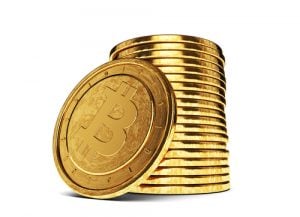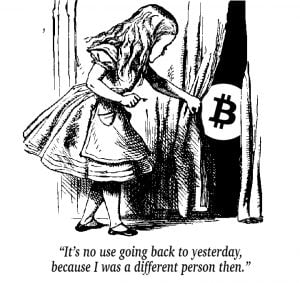By Jamie Redman,
It was like yesterday when it happened — the bitcoin price shot up and broke the spot price of gold. Jumping in the air, I couldn’t believe it; the news was like no other. Every news outlet in the world reported how the price of the digital currency rose an incredible 78-fold during 2013.
The 2013 Bitcoin Spike Will Not Be Forgotten
 It’s been three solid years since this time, and we are still trucking on. During that time when the price was over USD $1,000 a coin, many companies like Mt. Gox were still doing business. Earlier in April the price had rallied to $266 with the small country of Cyprus in fear of bank runs and economic failure. The price then took a steady dive after the European Union swept the crisis under the rug and smashed to a floor of $50 a coin.
It’s been three solid years since this time, and we are still trucking on. During that time when the price was over USD $1,000 a coin, many companies like Mt. Gox were still doing business. Earlier in April the price had rallied to $266 with the small country of Cyprus in fear of bank runs and economic failure. The price then took a steady dive after the European Union swept the crisis under the rug and smashed to a floor of $50 a coin.
In October the currency had yet another revival, and this one would peak like never before. Trading at roughly a hundred dollars and hearing about Subway owners accepting the currency, enthusiasm was rampant. Volume was surging in China, and rumors of the PBOC restricting use of virtual money were starting to spread. About a month earlier the Silk Road was taken down, and the currency wasn’t viewed in a positive light. Following this, governments all around the world started looking into bitcoin. In the U.S., a Senate committee dedicated to focusing on cryptocurrency was assembled to create a regulatory discussion.
One Bitcoin Was Worth More Than an Ounce of Gold

On November 18, the bitcoin price soared again to record highs of $680 a coin, and it was clear the rockets were blazing.
Forbes magazine called 2013 “The Year Of Bitcoin” and everyone’s favorite decentralized currency started raising eyebrows. Mt Gox at the time was the most popular trading engine on the market and was swapping bitcoins at an exponential rate. At the time, this was looked at as a natural phenomenon. However, over the course of the next few months, with the demise of Mt Gox and their insolvency, reports of bots trading the coins became prevalent.
I hold the moments when bitcoin had overtaken the price of silver and gold as very strong memories. 2013 was nearing a five-year run with the global economic recession, and unemployment was at high levels. Forecasters from the likes of Gerald Celente and others predicted impending financial doom worldwide, and countries like Greece looked to be faltering.
 When the bitcoin price shot through the roof during the fall months, many innovations were happening, and infrastructure was built. Andreessen Horowitz and accredited investors showed the world that venture capitalists were funding this architecture. In November, while everyone had their eyes on the price tickers, the New York Department of Financial Services initiated plans for a BitLicense. Despite this immense upward swing in price and infrastructure soon after the price cracked slowly dwindling downwards.
When the bitcoin price shot through the roof during the fall months, many innovations were happening, and infrastructure was built. Andreessen Horowitz and accredited investors showed the world that venture capitalists were funding this architecture. In November, while everyone had their eyes on the price tickers, the New York Department of Financial Services initiated plans for a BitLicense. Despite this immense upward swing in price and infrastructure soon after the price cracked slowly dwindling downwards.
Times have changed since the rally of 2013, a memory a lot of enthusiasts share. Mt Gox is deceased, and 2014 was called bitcoin’s worst year. Fast forward to now and the story has once again experienced a revival. Bitcoin had a solid 2015, staying stable in price all year long and resting at a rough $200 average most of the year. This 2016 fall season has seen yet another price spike and a keen interest in the technology behind Bitcoin. The blockchain concept has intrigued banks from all around the world. During 2015 significant interest grew into looking at the digital currency’s underlying technology. Most legacy institutions have been bolstering the ‘private ledger’ over the public cryptocurrency bitcoin.
How Will We Remember 2016?
 Bitcoin has been trading at roughly $760 a coin for the past couple of days after a high of $778 a week or so before. The digital currency has some more hurdles to face as political pundits are clamoring against encryption and digital currency’s use, in the name of protectionism. The recent rally has sparked revived enthusiasm, and people look for all the positive headlines.
Bitcoin has been trading at roughly $760 a coin for the past couple of days after a high of $778 a week or so before. The digital currency has some more hurdles to face as political pundits are clamoring against encryption and digital currency’s use, in the name of protectionism. The recent rally has sparked revived enthusiasm, and people look for all the positive headlines.
It’s not like the fall run of 2013, and the vibe is more mellow. The community is robust, and we know exciting times are continually happening. These times are just as powerful because we are making global headway and encryption and digital currency scares the central authorities. The question is if 2013 was the year of Bitcoin and 2014 was its worst year, what will we call 2016?

